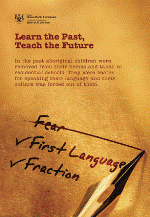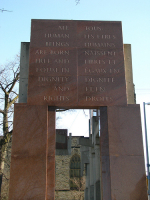2008: Celebrating the 60th Anniversary of the Universal Declaration of Human Rights
Universal Declaration of Human Rights: Introduction
Sixty years ago, nations of the world joined together in recognizing that all peoples, in all nations, are free and equal regardless of race, religion, economic status, age, gender or other personal characteristics. Through the signing of the Universal Declaration of Human Rights in 1948, the United Nations brought into being the first international document recognizing human rights as the foundation of peace, justice and freedom in the world.

The Universal Declaration outlines 30 basic rights essential for all human beings to achieve their full potential and to live a life free of fear and want. It was a unique approach that developed from the world saying 'never again' to the horrific events of World War Two, a war that brought a scale of atrocity never previously witnessed. The global death count is estimated to have been more than 50 million. War crimes were widespread: from the infamous Holocaust in which Nazi Germany sought to eliminate 'undesirables' such as Jews, Poles, Slavs, Roma, Sinti, the mentally and physically disabled, homosexuals and other persons, to the use of sex slaves, otherwise known as 'comfort women', by Japanese soldiers. Labour camps were used throughout the world and, disturbingly, World War Two brought the first testing of biological warfare by Japan and the use of atomic bombs in Nagasaki and Hiroshima by the United States of America. Read more...
Aboriginal and Indigenous Rights

In Canada, many of the Aboriginal peoples (First Nations, Métis and Inuit), have historically experienced numerous challenges. These have included economic marginalization, inadequate housing, limited access to healthcare due to geographic remoteness, low numbers of high school, college and university graduates, in addition to discrimination and loss of cultural traditions.
The global pattern of the marginalization and exploitation of indigenous peoples led the United Nations to develop a Declaration on the Rights of Indigenous Peoples to address their unique needs. This declaration sets out individual and collective rights to culture, identity, language, employment, health and education, and highlights the critical issue of discrimination. It also recognizes the right of indigenous peoples to their own social and economic development goals.
While recognition has been given on the international stage to the distinct needs of indigenous peoples, too many continue to live in hardship and lack full human rights. Indigenous peoples have been uprooted from their land, suffered discrimination and racism, and been marginalized economically and socially.
In Canada for example, First Nations people were unable to vote until 1960. The residential school system in the late 1800's and much of the 1900's involved the separation of Aboriginal youth from their families and culture and the attempt to assimilate them into the mainstream culture, resulting in a loss of language and tradition. The suffering of most indigenous people in Canada has been compounded by a cycle of poverty.
In 2005, a special report was presented to the UN Commission on Human Rights highlighting the situation of indigenous peoples worldwide. In this report, Canada, amongst other nations, was called upon to address issues of poverty, ill health and social strife in Aboriginal communities. While the Canadian government has put increased resources into programs for Aboriginal peoples, and has stated that the needs of Aboriginal Canadians are a pressing concern for all Canadians, Canada was one of eleven countries to vote against the UN Declaration on the Rights of Indigenous Peoples in 2007.
Aboriginal peoples in Canada still tend to be over-represented among the poor, the homeless, those with addictions and in the prison system. Discrimination in employment and housing makes it more difficult for many Aboriginal people to meet their basic needs. Aboriginal women suffer high instances of physical, sexual and domestic violence and abuse. Living conditions on some reserves are harsh and the opportunities limited. This lack of opportunity has led to an increased Aboriginal migration to cities, where people often face ongoing challenges and barriers to employment, further education and housing.
While these problems are complex, there are some signs of change. Recently, Canadian Prime Minister Harper made a formal public apology to survivors of the residential school system, marking a new era in Canada's acceptance of responsibility for the harm caused to Aboriginal individuals and communities. Compensation payments are being processed and a Truth and Reconciliation Commission is listening to those affected by residential schools. Through a more open acknowledgement of the wrongs of the past, it is hoped that a new relationship of respect can be established. See the Truth and Reconciliation Commission information on the Aboriginal Healing Foundation website at www.ahf.ca.
Recent changes to the Canadian Human Rights Act mean that, as of June 2008, First Nations people living on reserves can file complaints against the federal government. After a three-year transition period, the Canadian Human Rights Commission will also accept complaints against First Nations governments. This transition will be implemented in consultation with First Nations organizations.
Take the time to learn more about Aboriginal people in Canada and in your community. June 21 is National Aboriginal Day in Canada. First Nations offices, Métis organizations and Friendship Centres are a source of information and a place to engage with the Aboriginal community.
Learn More! Get Involved!
- Aboriginal Canada Portal
- Aboriginal Healing Foundation
- Aboriginal Multi-Media Society
- Amnesty International – Indigenous Issues/Take Action
- Canadian Broadcasting Corporation: Canadian Aboriginals
- Congress on Aboriginal Peoples
- Kairos Canada
- Indian and Northern Affairs Canada
- Indigenous Peoples' Caucus
- National Association of Friendship Centres
- Statistics Canada: Aboriginal Peoples Profile
Related International Human Rights Documents
- Convention concerning Indigenous and Tribal Peoples in Independent Countries, 1989
http://www.unhchr.ch/html/menu3/b/62.htm - United Nations Declaration on the Rights of Indigenous Peoples, 2007
http://www.un.org/esa/socdev/unpfii/en/declaration.html



